Pilates is more popular than ever, with people looking for effective, low-impact workouts they can do anywhere.
A dedicated Pilates app gives you the ability to offer structured programs, live sessions, and a thriving community—all while generating stable, recurring revenue.
If you’ve already built an engaged audience through social media or an online membership, launching your own app is the next step in growing your business. It gives you full control over your content, branding, and user experience.
In this guide, we’ll walk you through everything you need to know to create a successful Pilates app, from choosing the right platform to retaining loyal members.
2025 is a Great Time for Pilates Apps
There’s never been a better time to launch a Pilates app.
Pilates is surging in popularity, with more people turning to low-impact, core-strengthening workouts for flexibility, posture improvement, and overall wellness. Apps like Alo Moves, Pilates Anytime, Centr, and Lindywell are among the most downloaded wellness apps, proving that digital Pilates training is in demand. Chances are, you’ve tried one of these or seen Pilates influencers sharing their workouts online.
With so many big players in the fitness space, you might wonder if it’s too late to launch your own Pilates app. Let me assure you—it’s not. The demand for Pilates is growing, and there are countless ways to differentiate yourself and build a unique experience tailored to your audience.
According to SkyQuest, the global fitness app market is set to grow from $2.49 billion in 2024 to $9.6 billion by 2032—and Pilates is a major part of that expansion. Among Uscreen customers, Pilates creators have some of the highest engagement rates, proving that Pilates members are highly committed and active. This means there’s a huge opportunity to build a thriving business by offering structured Pilates programs, interactive challenges, and a strong online community.
We’ll talk about that shortly – first, let’s take a look at what will make a successful app in this competitive space.
Is Launching a Pilates App Really Worth It?
You might be wondering if the huge demand for Pilates could be better harnessed by monetizing on Instagram or YouTube instead of launching an app.
Sure, you could grow a following and even generate some revenue through social media. But here’s the reality: social media isn’t under your control.
- Algorithms dictate your reach and engagement. Your content could go viral one day and barely reach your audience the next.
- Limited branding options. Your brand is tied to Instagram’s or YouTube’s interface—you don’t have full control over the look, feel, or experience.
- Content restrictions. You can’t always post what you want, and community guidelines can limit how you share your expertise.
- Monetization risks. YouTube demonetization, lower ad revenue, and platform changes can disrupt your income overnight.
A large social media following is valuable, but the most successful Pilates creators aren’t relying on it as their primary revenue source. Instead, they build membership communities and launch their own apps—where they own their audience, control their pricing, and deliver premium experiences.
Take Range by Kara Duval, a Pilates brand that focuses on sustainable movement and core strength.
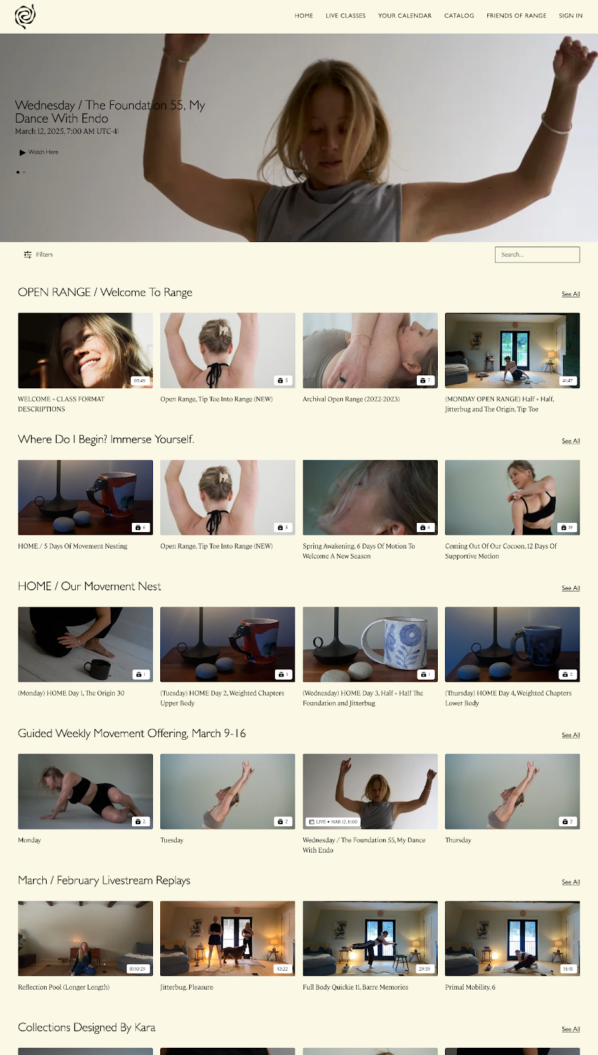
Kara has built an engaged community through social media, but her real business growth comes from her membership platform, where subscribers get access to structured Pilates programs, exclusive content, and ongoing support.
If you want to create a sustainable, long-term Pilates business, an app isn’t just an option—it’s the best way to secure stable revenue, build a thriving community, and ensure that your content remains accessible on your own terms.
What Makes a Successful Pilates App?
1. A Great Service
There are many different ways to structure a Pilates app, but the most successful ones have one thing in common: they deliver an outstanding experience that keeps members coming back.
Some Pilates apps focus on guided mat workouts, while others offer reformer routines, mobility training, or personalized programs. Some provide a mind-body approach that blends Pilates with meditation, while others emphasize strength and athletic conditioning.
There’s plenty of opportunity in the market, but it’s also a competitive space. To stand out, your app must solve a problem better or differently than anything else available. If users don’t feel that your app is engaging, effective, and well-structured, they’ll quickly move on to another solution.
Whether you focus on core strength, injury prevention, flexibility, or all of the above, your app needs to make progress feel tangible and keep users motivated to practice regularly.
2. Great User Experience
You might have the most effective Pilates workouts or the best personalized programs, but if your app isn’t intuitive and easy to navigate, users won’t stick around. People expect a seamless experience, with simple navigation, fast loading times, and clear video organization.

A great user interface is essential. If you’re not interested in building one yourself, using a platform that provides a polished, professional design can save you time and effort. The most successful Pilates apps have clean layouts, easy-to-follow video libraries, and smooth mobile functionality.
Another key factor is accessibility. Your users need to be able to stream their workouts anytime, anywhere. While most members prefer using mobile apps for convenience, some still want access through a web browser or other devices.
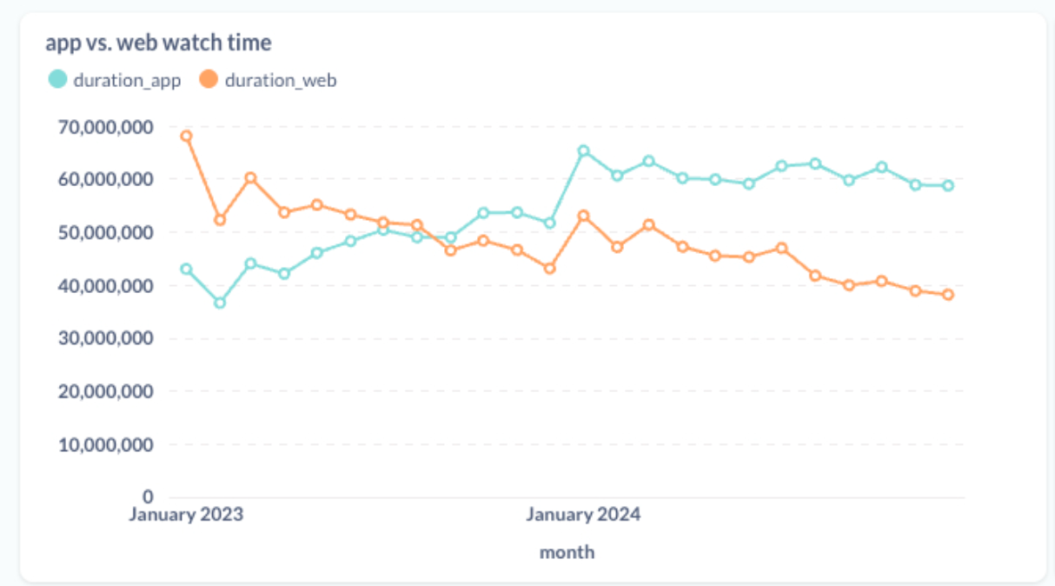
This is why choosing the right fitness streaming platform is important – you can build an audience using a fitness membership site and then launch an app when you have a community large enough to support it. That’s how some of our favorite successful fitness streaming brands have done it.
3. Great Marketing
If you want a lot of downloads (and paying subscribers), you’ll need to get your Pilates app in front of the right people. That means marketing. If you already have an audience—like a strong YouTube or Instagram following—this part will be much easier.
If you’re starting from scratch, you’ll need to invest time in growing your visibility. That could mean building a social media presence, collaborating with influencers, or partnering with a Pilates studio to cross-promote your app. Attending industry events, networking, or guest teaching in existing online communities can also help.
No matter how big your audience is right now, choosing an app-building tool that includes integrated marketing solutions will make promoting your app much simpler.
4. Great Community
Not every Pilates app has a built-in community, but the most successful ones do. Having a strong community sets you apart and keeps members engaged for the long run.
Here’s a statistic to remember: Uscreen customers with an active community see half the member churn of customers without one. And those with mobile apps see up to 78% of their community engagement happen through their mobile apps.
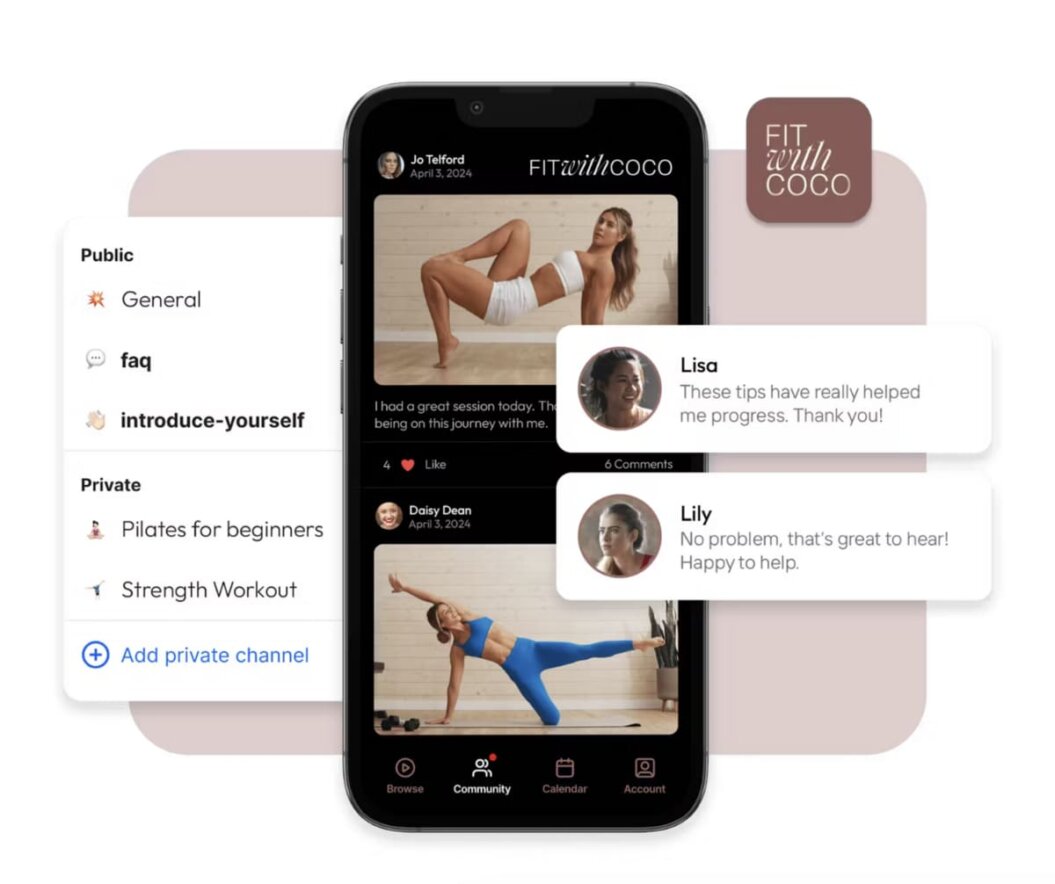
Because churn is one of stable revenue’s greatest enemies, that’s a very big deal. So it’s worth investing in the community around your service and your app. Fortunately, there are lots of ways to build and grow an online fitness community once you’ve built your app.
How to Create a Pilates App
We’ve covered why now is the perfect time to launch a Pilates app and what makes a great one. Now, let’s get into the details of how to make it happen.
1. Decide what kind of Pilates app you’ll build
There are many types of Pilates apps. What do you want to create?
You could share your own live or recorded workouts. Or offer live coaching. Some apps help users track their progress, improve their mobility, or take a holistic approach to wellness.
What do you hope to offer to your users? The answer will determine your approach to the rest of the steps in the process. A Pilates app focused on equipment-based workouts may need detailed instructional content, while a mat-based program may focus more on progression tracking. Thinking about these issues early will help you lay the proper foundation for your app.
For the rest of our examples, we’ll discuss a video-based workout app that offers recorded and live workouts as well as community engagement features. But the points apply to almost every type of Pilates app.
Decide Where Your App Will Be Available
While you’re thinking about the type of Pilates app you’d like to build, remember that there are multiple platforms where you can make it available. You’re not just limited to mobile apps.
Smart TV apps, for example, are popular among Pilates creators because it gets your workouts right into your users’ living rooms. If you’re interested in smart TV app development, check out these guides to see what the process is like:
- How to Create Your Own Android TV App
- Building a Samsung TV App
- How to Create a Roku Channel
- How to Build an Apple TV App
- LG TV App Development
Mobile apps are great, too. Many fitness creators build an iOS video streaming app because Apple products are so popular. If you choose the right platform, it’s usually very easy to develop an Android streaming app alongside it, too.
And don’t forget about other mobile devices—some fitness creators have even used Uscreen to create Apple Watch fitness apps for tracking progress and engagement.
2. Focus on Your Niche
Targeting a specific niche is an effective way to differentiate your online Pilates business. “Pilates for everyone” is too broad. There’s a ton of competition in general fitness, so the more specific your focus, the easier it is to attract loyal members. If you already have a strong social media following, you’ve likely already carved out a niche.
For example, a Pilates app could target frequent travelers looking for no-equipment workouts, new moms wanting safe postnatal recovery routines, or people recovering from injuries who need a structured mobility program. These groups are easier to reach and more likely to commit to a membership.
When launching your app, stay focused on your niche. The audience that has already engaged with your content will be your best customers when you launch your mobile or smart TV app.
A great example is Fittest Core, a brand that helps pre- and postpartum moms exercise safely and confidently. This audience wasn’t being sufficiently served, so Macy Pruett stepped in and launched a successful membership community with online workouts tailored to their needs.
When expanding into an app, don’t lose sight of what made your Pilates content successful in the first place. You can always expand later, but staying focused at launch will help you grow an engaged, committed audience.
3. Create Your Pilates Content
The type of app you’re creating will determine what “content” means for this step. In the case of a video-based Pilates app, it means recording and editing workout videos. If your app includes structured programs, you might also need guided progressions, mobility assessments, or written explanations of movements and modifications.
If you don’t already have a large content library, start building it early. You might not need as much content as you think—among our customers who offer streaming memberships, the average is 15 hours of video at launch. The key is to have enough high-quality content that makes users feel your app is worth paying for.
Some Pilates instructors prefer to create content on the fly. M/BODY, an online fitness studio, films 95% of its content live, then uses Uscreen to automatically upload the recorded videos for members to watch later. This live-first approach, combined with flexible monetization and a dedicated community, has helped M/BODY generate $40,000 per month.
4. Decide on a Monetization Model
How you plan to monetize your app will determine how you structure it and what features to include.
Here are several ways to monetize a Pilates app (these principles apply to most video-based workout apps and communities):
- Subscription video on demand (SVOD): Users pay a regular fee (monthly or annually) for access to your videos. You could offer full access to everything or create tiered memberships with different content levels.
- Transactional video on demand (TVOD): Users pay to rent or purchase individual classes, structured programs, or workshops.
- One-time fee: Users make a single payment for lifetime access to your app’s content.
- Community-only access: If your Pilates app has a strong social component, you can offer access to your community as a separate membership option.
- Hybrid approach: A mix of the above. For example, you could offer unlimited access via membership while also allowing users to purchase individual classes.
Power Nation Fitness’s three-tiered membership model is a great example of flexible monetization. New members can clearly see their different access levels and choose the one that fits them best.
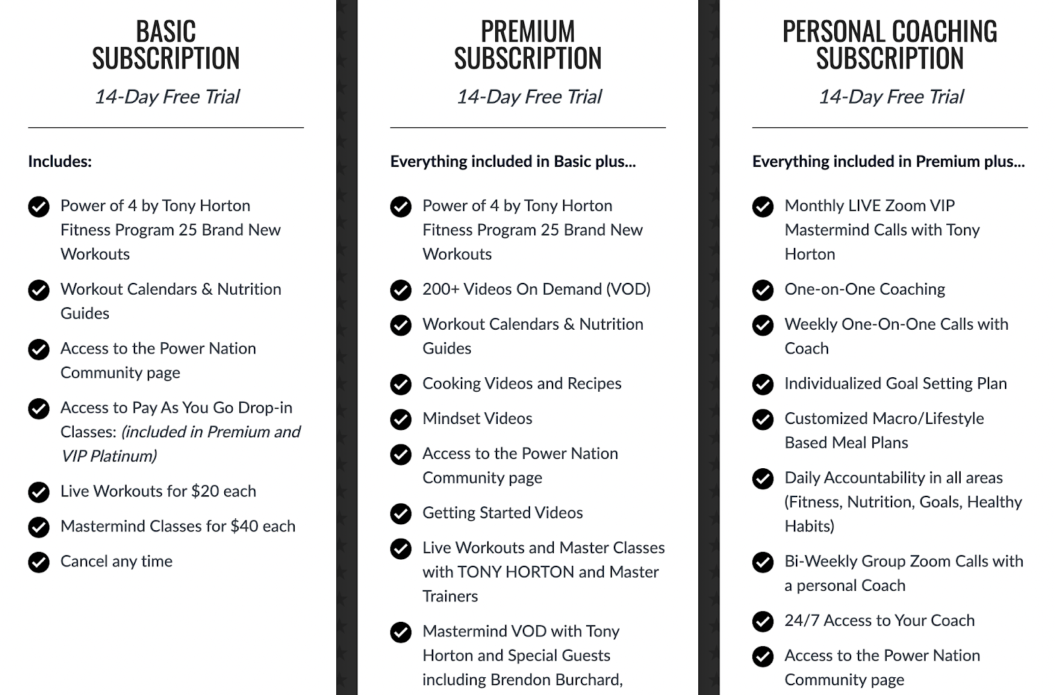
5. Determine How You’ll Build Your App
There are three main ways to develop a Pilates app: using a no-code platform, coding it yourself, or hiring a developer. Each option has its pros and cons depending on your budget, timeline, and technical expertise.
Creating a Pilates App with a No-Code Platform
Best for instructors who want to launch quickly with minimal expense and no technical expertise.
When you use a no-code platform to build a Pilates app, the platform handles all the technical work for you. You’ll customize the app by choosing your brand colors, uploading your logo, and making basic design decisions, but the development is done for you.
This is especially good for creators who want to build video-based apps, as there are many over-the-top (OTT) app builders that can help you get started. These apps make it easy to build a content library, live stream workouts, or offer remote coaching to your users.
It’s also a good option if you want to expand beyond iPhone and Android apps. Our workout video business could have an Apple Watch app, for example, or we could publish Roku and Samsung apps so users can get our videos on their smart TVs.
No-code platforms sit in the middle of the price spectrum, with costs typically starting at a couple of hundred dollars per month, depending on the platform and features you need.
Building a Pilates App from Scratch
Best for instructors with extensive technical expertise who want full control over their app.
If you have experience developing apps, you might consider coding your Pilates app yourself. This gives you full control over every feature and design element.
This option makes sense if your app requires complex integrations. For example, if you want to track user progress through AI-based movement analysis or integrate real-time biometric feedback, coding from scratch may be necessary.
One of the biggest advantages of this approach is that the actual development cost is free—you’ll only need to pay for APIs, hosting, and maintenance. However, it requires significant time and expertise, so it’s not the best fit for most instructors.
Hiring a Developer for Your Pilates App
Best for instructors with a complex app idea and a large budget.
If your Pilates app requires custom-built features that no existing platform can offer, hiring a developer or agency might be the best option. This approach lets you build anything you want, from personalized workout recommendations to advanced tracking and analytics.
However, full-scale development is expensive. A custom app can cost $20,000 or more, and ongoing maintenance adds additional costs. While this option delivers a polished, unique experience, it’s not financially realistic for most Pilates instructors.
For most creators, using a no-code platform is the best way to launch quickly, keep costs manageable, and focus on building an engaged membership rather than dealing with technical complexities.
6. Launch Your App and Start Building Your Community
Once your app is built (which could take as little as 30 days with a no-code platform or over six months with custom development), it’s time to get it in front of your audience. After it’s available in the app store, your primary focus will be marketing your Pilates app and growing your community.
Leverage Social Media
If you have a social media following or regularly share Pilates content online, you already have an audience that values your expertise. Make sure they know about your app by mentioning it frequently, showing behind-the-scenes content, and sharing testimonials from early users.
A great example is Find What Feels Good, the app built by Yoga With Adriene. Adriene Mishler had over 13 million YouTube subscribers, but she and her business partner Chris Sharpe wanted to offer a more structured, app-based experience. While you may not have an audience that size, even a small engaged following can be a great starting point for promoting your app.
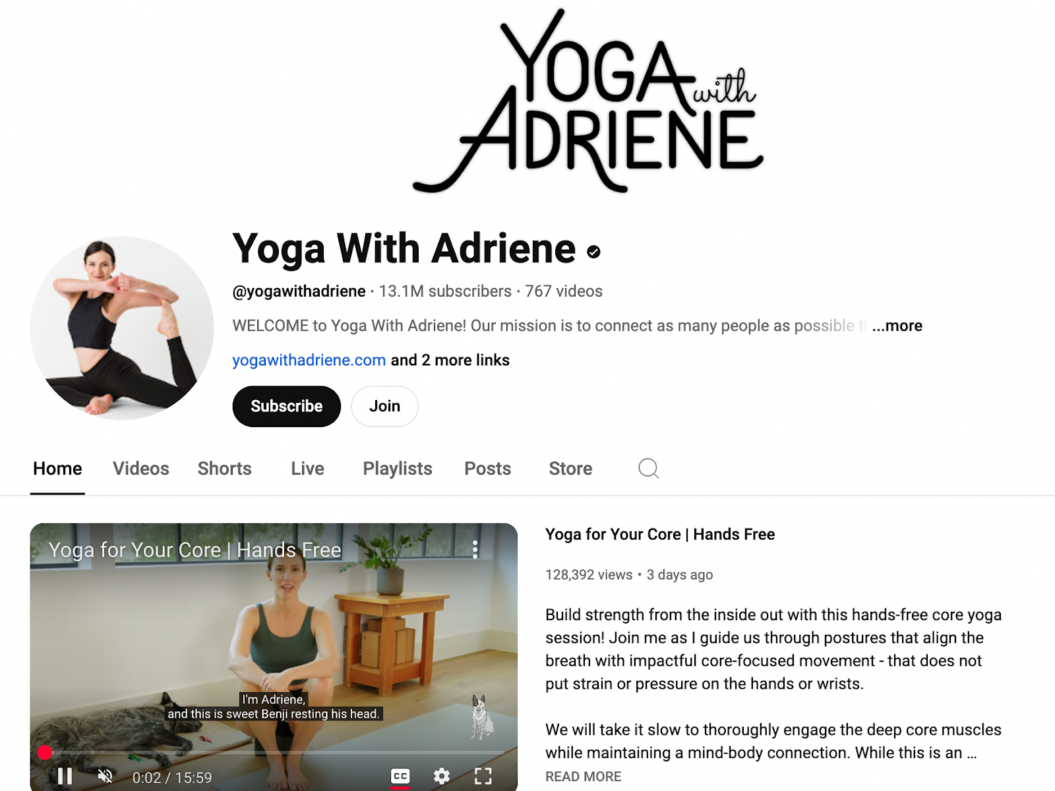
Find Media Opportunities
Expanding your audience beyond social media is key to driving more sign-ups. Consider partnering with people who are already reaching your ideal customers.
- Guest on podcasts to talk about your unique approach to Pilates.
- Collaborate with YouTube creators or fitness influencers.
- Pitch articles or interviews to media outlets that cover health and wellness.
- Offer a free online workshop where potential members can experience your style before subscribing.
Optimize Your App Store Copy
App store optimization (ASO) is essential to making sure people can find your app. Optimizing your app’s title, description, and keywords can increase downloads and attract the right audience.
We have an entire guide on app store optimization, and it’s a great place to start.
Emphasize Community
Marketing will bring users to your app, but community is what keeps them there and encourages them to invite their friends. Community-driven Pilates apps see higher retention and engagement, which translates into long-term revenue.
There are many ways to build a strong community around your app:
- Host live Q&A sessions or Pilates challenges
- Encourage members to share their progress and ask questions
- Personally welcome new members and guide them through the app
- Use features like discussion forums, private messaging, or accountability groups
The Bloom Method is a pre- and post-natal fitness app and community, and founder Brooke Cates says that community is one of her favorite parts of her membership community. With public and private channels for members to communicate in, moderated conversations, and mobile calendaring, every member feels like part of the Bloom family.
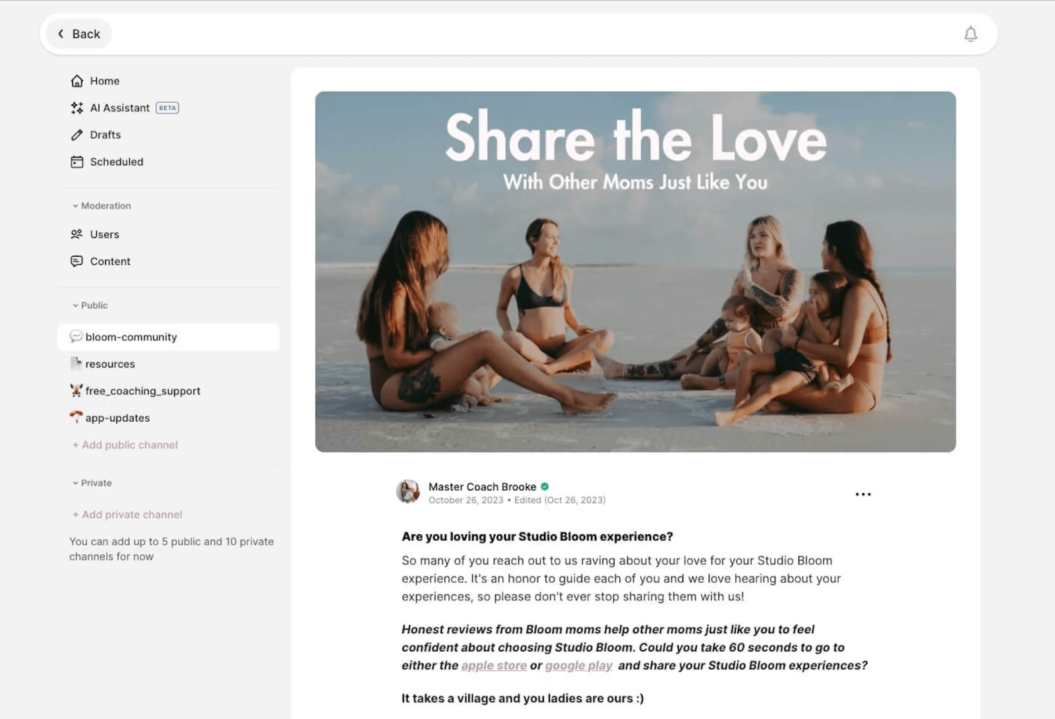
That sense of community helps The Bloom Method bring in over $1 million every year.
Get Started Building Your Pilates App Today
The most important step in launching a Pilates app is getting started. If you have an idea, it’s worth pursuing, and with the right approach, you can turn it into a success. You just need to take the first step.
Start brainstorming. Start planning. Think about the app you want to bring to the world. Maybe it’s a mat-based Pilates membership with progressive programs, a reformer Pilates coaching app, or something entirely new that no one has thought of yet. Whatever it is, it’s yours to create.
And when you’re ready to start building it, Uscreen will be here to help. If you’re ready to start talking about how we can help you turn your dream into a reality, you can start the conversation by reading about our app-building process or checking out our on-demand demo.
If you’re not quite ready yet, take a look at some of the successful health and fitness brands we’ve worked with in the past. Maybe one of them will inspire you to launch your own fitness app!
Build, launch and manage your membership, all in one place.






